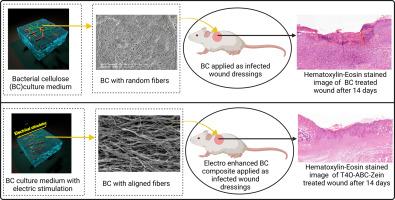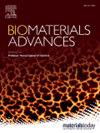用植物性绿色材料定制的电改性细菌纤维素在感染性伤口愈合方面的应用
IF 5.5
2区 医学
Q2 MATERIALS SCIENCE, BIOMATERIALS
Materials Science & Engineering C-Materials for Biological Applications
Pub Date : 2024-10-25
DOI:10.1016/j.bioadv.2024.214087
引用次数: 0
摘要
由于抗生素耐药微生物的增加,有效治疗受感染的伤口仍然是一项挑战。要解决这一问题,就必须开发出具有强大抗菌特性的先进材料。本研究采用浸渍扩散法研制出了一种独特的电改性细菌纤维素(EBC)与尿囊素(ABC)和玉米蛋白的复合材料。形态结构分析表明,玉米蛋白和排列整齐的纤维分布均匀,证实了 ABC-玉米蛋白复合材料的合成。衰减全反射-傅立叶变换红外光谱(ATR-FTIR)进一步证实了 ABC-玉米蛋白的形成。对 ABC-玉米蛋白的 X 射线衍射(XRD)分析表明,其晶体结构与 EBC 相似。ABC-Zein 具有机械完整性(拉伸强度:1.15 ± 0.21 兆帕)、热稳定性(降解温度:290 °C)、多孔结构(孔隙率:40.23 ± 0.21 %)和亲水性(水接触角:53.3 ± 5.3°)。此外,从茶树油中提取的抗菌剂 terpinen-4-ol (T4O) 被加入到 ABC-Zein 复合材料中。生物学研究证实了 T4O-ABC-Zein 复合材料的抗菌功效(金黄色葡萄球菌抑制率:88.5 ± 7.19 %)和生物相容性(细胞存活率:84.95 ± 5.6 %,溶血率:4.479 ± 0.39 %)。第 7 天时,排列整齐的纤维结构、玉米蛋白和抗菌剂 T4O 的共同作用显著增强了感染伤口的愈合,促进了炎症反应、颗粒组织形成、细胞增殖和血管生成。到第 14 天,T4O-ABC-Zein 可促进伤口完全愈合,出现再上皮化、胶原 I 沉积以及 CD 31、Ki67 和 α-SMA 下调。总之,创新的 T4O-ABC-Zein 复合材料具有排列整齐的纤维结构、更好的生物相容性和抗菌特性,在治疗感染性伤口方面潜力巨大。本文章由计算机程序翻译,如有差异,请以英文原文为准。

Electricallymodified bacterial cellulose tailored with plant based green materials for infected wound healing applications
Effective treatment of infected wounds remains a challenge due to the rise of antibiotic-resistant microorganisms. The development of advanced materials with strong antimicrobial properties is necessary to address this issue. In this study, a unique composite of electrically modified bacterial cellulose (EBC) with allantoin (ABC) and zein was developed by dipping diffusion method. Morphological structural analysis revealed a uniform distribution of zein and aligned fibers, confirming the synthesis of the ABC-Zein composite. The formation of ABC-Zein was further confirmed by attenuated total reflection-Fourier transform infrared (ATR-FTIR), which displayed additional peaks corresponding to EBC, indicating the incorporation of zein into ABC. X-ray diffraction (XRD) analysis of ABC-Zein demonstrated a similar crystalline structure with EBC. The ABC-Zein showed mechanical integrity (tensile strength: 1.15 ± 0.21 MPa), thermal stability (degradation temperature: 290 °C), porous structure (porosity: 40.23 ± 0.21 %), and hydrophilic (water contact angle: 53.3 ± 5.3°) properties. Furthermore, the antimicrobial agent terpinen-4-ol (T4O), derived from tea tree oil, was incorporated into the ABC-Zein composite. Biological studies confirmed the antimicrobial efficacy (Staphylococcus aureus inhibition: 88.5 ± 7.19 %) and biocompatible (cell viability: 84.95 ± 5.6 %, hemolysis: 4.479 ± 0.39 %) nature of the T4O-ABC-Zein composite. The combined effects of the aligned fiber structure, zein protein, and antimicrobial T4O significantly enhanced infected wound healing by day 7, promoting inflammatory response, granular tissue formation, cell proliferation, and angiogenesis. By day 14, T4O-ABC-Zein facilitated complete wound healing, with reepithelization, collagen I deposition, and downregulation of CD 31, Ki67, and α-SMA. Overall, the innovative T4O-ABC-Zein composite, with an aligned fiber structure, improved biocompatibility, and antimicrobial properties, holds significant potential for the treatment of infected wounds.
求助全文
通过发布文献求助,成功后即可免费获取论文全文。
去求助
来源期刊
CiteScore
17.80
自引率
0.00%
发文量
501
审稿时长
27 days
期刊介绍:
Biomaterials Advances, previously known as Materials Science and Engineering: C-Materials for Biological Applications (P-ISSN: 0928-4931, E-ISSN: 1873-0191). Includes topics at the interface of the biomedical sciences and materials engineering. These topics include:
• Bioinspired and biomimetic materials for medical applications
• Materials of biological origin for medical applications
• Materials for "active" medical applications
• Self-assembling and self-healing materials for medical applications
• "Smart" (i.e., stimulus-response) materials for medical applications
• Ceramic, metallic, polymeric, and composite materials for medical applications
• Materials for in vivo sensing
• Materials for in vivo imaging
• Materials for delivery of pharmacologic agents and vaccines
• Novel approaches for characterizing and modeling materials for medical applications
Manuscripts on biological topics without a materials science component, or manuscripts on materials science without biological applications, will not be considered for publication in Materials Science and Engineering C. New submissions are first assessed for language, scope and originality (plagiarism check) and can be desk rejected before review if they need English language improvements, are out of scope or present excessive duplication with published sources.
Biomaterials Advances sits within Elsevier''s biomaterials science portfolio alongside Biomaterials, Materials Today Bio and Biomaterials and Biosystems. As part of the broader Materials Today family, Biomaterials Advances offers authors rigorous peer review, rapid decisions, and high visibility. We look forward to receiving your submissions!

 求助内容:
求助内容: 应助结果提醒方式:
应助结果提醒方式:


